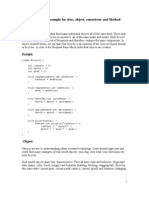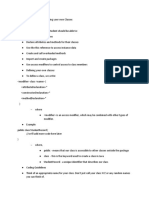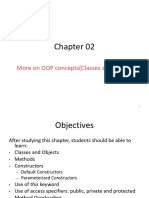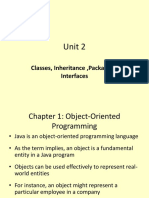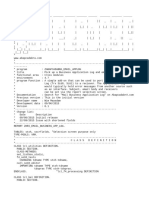LAB04-Department of Computer Science - Copy
Uploaded by
kundilmuhammad59LAB04-Department of Computer Science - Copy
Uploaded by
kundilmuhammad59Department of Computer Science
Faculty of Physical Sciences
Ahmadu Bello University, Zaria
COSC 211 : Object Oriented Progr amming I - LAB04
Objectives:
Learn how to create classes that can beused in creating objects
Understand the purpose of constructorsand how they differ from methods
Differentiate between static and instantvariables (and methods)
Differentiate between accessor and mutator methods
1. Classes as factory of objects
So far, all the classes we have been written are applications containing the main method.
Another type of class is that which is written not necessarily to be executed as an application, but to be used in
creating objects. Such type of classes are designed such that they describe the state and methods for a set of
objects. This is achieved by using instant variables, instant methods and constructors.
Instant Variables: These are variables declared without using thestatic keyword. Such variables are only
accessed through an object of the class and each object has its own cop y of the variables – hence the name
instant. Instant variables are used to store the state of an object and are usually declared as
private so that they
cannot be accessed directly by other objects.
Instant methods: These are methods declared without using thestatic keyword. They are normally used to
describe the behavior of objects of a particular class.Instant methods are normally declared aspublic so that
they could be accessed by other objects.
Constructor: These are used to initialize the fields (variables) of an object at the time the object is being created.
Constructors must have the same name as the class, they have no return type and they are implicitly public.
Example 1: The following shows two classes. A class, Box, which specify the fields, a constructor and methods of
a box object, and a class, BoxDemo, which creates two Box objects and called their methods.
public class Box {
private double length , width , height; //instance variables
public Box(double boxLength , double boxWidth , double boxHeight) { //constructor
length = boxLength;
width = boxWidth;
height = boxHeight;
}
public double volume() { //instant methods
return length * width * height;
}
public double surfaceArea() {
return 2*(length*width + length*height +width*height);
}
}
public class BoxDemo {
public static void main(String[] args) {
// Create two Box objects
Box box1 = new Box(20.0, 10.0, 15.0);
Box box2 = new Box(6.0, 4.0, 2.0);
double volume, area;
// Get and display volume and surface area of box1
volume = box1.volume();
area = box1.surfaceArea();
System.out.println("The volume of box1 is " + volume + " cubic cm");
System.out.println("The surface area of box1 is "+area+" square cm\n");
// Get and display volume of surface area box2
System.out.println("The volume of box2 is " + box2.volume() + " cubic cm");
System.out.println("The surface area of box2 is "+area+" square cm\n");
}
}
2. Difference between static and instance variables
If a variable is declared asstatic then there will be only one copy of the variable, which can be access though the
class name, even without creating any object of the class. Thus, such variables are sometimes calledclass
variables. Such a variable cannot be used to store the state of an object since each object has its own state.
Example 2: The following example shows the difference between static and non-static variables.Notice that
both the class Circle and the class CircleDemo are stored in the same file.In this case, only one of the classes
should be declared as public – the one containing the main method.The file should also have the same name as
this public class.
// Demonstrating the use of static variables.
class Circle {
private static int numberOfCircles = 0; //a static variable
private double radius; //instance variables
public Circle(double circleRadius) {
numberOfCircles++;
radius = circleRadius;
}
public double area() {
return Math.PI * radius * radius;
}
public double circumference() {
return 2.0 * Math.PI * radius;
}
public static int getNumberOfCircles() {
return numberOfCircles;
}
}
public class CircleDemo {
public static void main(String[] args) {
// The static method getNumberOfCirclescan be called before creating any circle
object
System.out.println("The number of circles is " + Circle.getNumberOfCircles());
Circle circle1 = new Circle(8.5);
System.out.println("The number of circles is " + Circle.getNumberOfCircles());
Circle circle2 = new Circle(5.0);
System.out.println("The number of circles is " + Circle.getNumberOfCircles());
System.out.println("The area of the first circle is \t" + circle1.area() + "
square cm");
System.out.println("The circumference of the first circle is\t" +
circle1.circumference() + " cm");
System.out.println("The area of the second circle is\t" + circle2.area() + "
square cm");
System.out.println("The circumference of the second circle is\t" +
circle2.circumference() + " cm\n\n");
}
}
3. Accessor and Mutator methods
It is a good programming principle to always declare instance variables as private. However, it is O.K. to allow
indirect access to these variables by providing public methods. Some of these method only access but do not
change the variables, hence they are calledaccesor methods. Those that do not only access, but also mak e
changes to these variables are calledmutator methods.
Example 3: The follows shows example of accessor and mutator methods.
// Demonstrating using accessor and mutator methods.
class Rectangle {
private double length , width;
public Rectangle(double rectangleLength ,double rectangleWidth) {
length = rectangleLength;
width = rectangleWidth;
}
public double area() {
return length * width;
}
// Accessor methods
public double getLength() {
return length;
}
public double getWidth() {
return width;
}
// Mutator methods
public void setLength(double newLength) {
length = newLength;
}
public void setRectangleWidth(float newWidth) {
width = newWidth;
}
}
public class RectangleDemo {
public static void main(String[] args) {
// Create one Rectangle object
Rectangle rectangle = new Rectangle(20.0, 10.0);
// Get and display the area of rectangle
double area = rectangle.area();
System.out.println("The area of the rectangle is\t" + area + " square cm");
// Get and display the length of rectangle
//Note: we cannot use rectangle.length
System.out.println("The length of the rectangle is\t" + rectangle.getLength() +
" cm");
// Modify the length of rectangle1 to 12.0
//We must use a mutator method to changethe value of a private instance
variable
rectangle.setLength(12.0);
// Get and display the new length of therectangle
System.out.println("The new length of the rectangle is " +
rectangle.getLength() + " cm");
// Get and display the new area of therectangle
System.out.println("The new area of the rectangle is " + rectangle.area() + "
square cm\n\n");
}
}
4. Assignment.
1. Open the folder lab04 , Study, compile, and then execute each of the three demo
applications:
· BoxDemo
· CircleDemo
· RectangleDemo
2. Write a java program containing two classes: BankAccount and BankAccountDemo.
The class BankAccount must contain the following:
· an instance variableaccountNumber of type int.
· an instance variablecustomerName of type String
· an instance variablebalance of type double.
· a constructor that initializes each of the instance variables.
· a method deposit.
· a method withdraw
· a method getBalance.
The class BankAccountDemo must:
· Prompt for and read the account number for the
customer.
customer.
· Prompt for and read the name of the customer.
· Prompt for and read the initial balance for the
customer.
· Create a bankAccount object for the customer.
· Prompt for and read an amount to be deposited.
· Display the current balance for the customer after
the deposit.
· Prompt for and read an amount to be withdr
awn.
· Display the current balance of the customer after
the withdrawal.
3. Write two java classes, Student and StudentDemo in separate files. The class
Student should contain the following:
· an instance variablename of type String.
· an instance variableiDNumber of type int
· three instance variablesquiz1, quiz2, quiz3 of type double.
· a constructor that initializes each of the instance variables.
· a get method for each of the instance variables.
· three set method, one for each of quiz1, quiz2 and quiz3
· a method average to return the average of the three quizzes.
· a method printDetails to print the details of a student object in the following format:
Student Name: ??????????
Student ID: ???????????
Quiz Grades: ??????? ????????? ????????
The class StudentDemo must:
· Create an object of type Student, supplying values
for name, ID number and three quizzes in the
constructor call.
· calls the printDetails method to print the details of
the student
· calls the average method to get the average and
print it.
· Prompts for and read the new grade for quiz3
· calls the setQuiz3() method to change the value of
quiz3 to the value entered by the user.
· prints the details and the average again.
You might also like
- Object Oriented Programming - Chapter 2 - ClassesNo ratings yetObject Oriented Programming - Chapter 2 - Classes55 pages
- Object Oriented Programming Chapter Two Classes and ObjectsNo ratings yetObject Oriented Programming Chapter Two Classes and Objects79 pages
- 4 Chapter 3 - Basic Concept of Classes & EncapsulationNo ratings yet4 Chapter 3 - Basic Concept of Classes & Encapsulation35 pages
- Chapter 05 - Objects and Classes in JavaNo ratings yetChapter 05 - Objects and Classes in Java51 pages
- Class:10 Subject: Computer Applications: LS 10. Constructors Important PointsNo ratings yetClass:10 Subject: Computer Applications: LS 10. Constructors Important Points7 pages
- Unit 2: Classes, Inheritance, Packages & InterfacesNo ratings yetUnit 2: Classes, Inheritance, Packages & Interfaces156 pages
- Java Programming Tutorial OOP ExercisesNo ratings yetJava Programming Tutorial OOP Exercises47 pages
- Java Programming Tutorial With Screen Shots & Many Code ExampleFrom EverandJava Programming Tutorial With Screen Shots & Many Code ExampleNo ratings yet
- Field Alert Report Form - Questions and Answers - FDANo ratings yetField Alert Report Form - Questions and Answers - FDA4 pages
- MIPS syscall functions available in MARSNo ratings yetMIPS syscall functions available in MARS1 page
- Python For Data Science, AI & Development - IBM - Course Info - CourseraNo ratings yetPython For Data Science, AI & Development - IBM - Course Info - Coursera1 page
- Software Cost Estimation: Static Multivariable ModelNo ratings yetSoftware Cost Estimation: Static Multivariable Model9 pages
- Arrays and Pointers in C: Alan L. Cox Alc@rice - EduNo ratings yetArrays and Pointers in C: Alan L. Cox Alc@rice - Edu26 pages
- Problem Solving and Python Programming LaboratoryNo ratings yetProblem Solving and Python Programming Laboratory59 pages
- Node JS - Design Pattern: Jose J TharayilNo ratings yetNode JS - Design Pattern: Jose J Tharayil14 pages
- Chapter 26 - Cleanroom Software EngineeringNo ratings yetChapter 26 - Cleanroom Software Engineering3 pages
- Instant download (Ebook) jQuery Mobile by Jon Reid ISBN 9781449306687, 1449306683 pdf all chapter100% (3)Instant download (Ebook) jQuery Mobile by Jon Reid ISBN 9781449306687, 1449306683 pdf all chapter81 pages
- History of The Java™ Programming LanguageNo ratings yetHistory of The Java™ Programming Language6 pages
- 21130004-OB-GEN-SCH-001 - B - Project ScheduleNo ratings yet21130004-OB-GEN-SCH-001 - B - Project Schedule5 pages
- FFRI PPT ARMv8-M TrustZone A New Security Feature For Embedded SystemsNo ratings yetFFRI PPT ARMv8-M TrustZone A New Security Feature For Embedded Systems12 pages
- Object Oriented Programming Chapter Two Classes and ObjectsObject Oriented Programming Chapter Two Classes and Objects
- 4 Chapter 3 - Basic Concept of Classes & Encapsulation4 Chapter 3 - Basic Concept of Classes & Encapsulation
- Class:10 Subject: Computer Applications: LS 10. Constructors Important PointsClass:10 Subject: Computer Applications: LS 10. Constructors Important Points
- Unit 2: Classes, Inheritance, Packages & InterfacesUnit 2: Classes, Inheritance, Packages & Interfaces
- Java Programming Tutorial With Screen Shots & Many Code ExampleFrom EverandJava Programming Tutorial With Screen Shots & Many Code Example
- Field Alert Report Form - Questions and Answers - FDAField Alert Report Form - Questions and Answers - FDA
- Python For Data Science, AI & Development - IBM - Course Info - CourseraPython For Data Science, AI & Development - IBM - Course Info - Coursera
- Software Cost Estimation: Static Multivariable ModelSoftware Cost Estimation: Static Multivariable Model
- Arrays and Pointers in C: Alan L. Cox Alc@rice - EduArrays and Pointers in C: Alan L. Cox Alc@rice - Edu
- Instant download (Ebook) jQuery Mobile by Jon Reid ISBN 9781449306687, 1449306683 pdf all chapterInstant download (Ebook) jQuery Mobile by Jon Reid ISBN 9781449306687, 1449306683 pdf all chapter
- FFRI PPT ARMv8-M TrustZone A New Security Feature For Embedded SystemsFFRI PPT ARMv8-M TrustZone A New Security Feature For Embedded Systems

